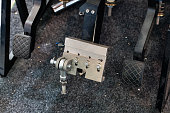Harmonic and cycloidal gearboxes are both styles of gear programs that present velocity reduction and torque multiplication. Nevertheless, they operate dependent on distinctive ideas and cycloidal gearbox factory have distinct qualities. Here are the critical distinctions involving harmonic and cycloidal gearboxes:
Working Basic principle:
– Harmonic Gearbox: A harmonic gearbox, also recognised as a strain wave gearbox, operates based on the theory of flex spline and wave generator. It is composed of a versatile spline (flex spline), a rigid outer spline (round spline), and an elliptical or wave-shaped ingredient (wave generator). The movement of the wave generator results in a deformity in the flex spline, resulting in a relative movement involving the flex spline and round spline, which creates the pace reduction and torque multiplication.
 – Cycloidal Gearbox: A cycloidal gearbox, also recognized as a cycloidal generate or cycloidal reducer, operates centered on the principle of the cycloidal movement. It is composed of an input shaft, eccentric pins or cams, a cycloidal disc, and an output shaft. The eccentric pins or cams, when rotated, induce the cycloidal disc to move in a cycloidal movement, ensuing in output rotation. The various points of contact concerning the pins or cams and the cycloidal disc help torque transmission and pace reduction.
– Cycloidal Gearbox: A cycloidal gearbox, also recognized as a cycloidal generate or cycloidal reducer, operates centered on the principle of the cycloidal movement. It is composed of an input shaft, eccentric pins or cams, a cycloidal disc, and an output shaft. The eccentric pins or cams, when rotated, induce the cycloidal disc to move in a cycloidal movement, ensuing in output rotation. The various points of contact concerning the pins or cams and the cycloidal disc help torque transmission and pace reduction.
Gear Layout:
– Harmonic Gearbox: Harmonic gearboxes typically have a compact structure and include an elliptical wave generator that deforms the flex spline to produce the preferred motion. They frequently have a high equipment reduction ratio and exhibit high precision and lower backlash. Harmonic gearboxes are normally utilised in purposes the place large precision and compact size are essential, this sort of as robotics and aerospace.
– Cycloidal Gearbox: China cycloidal gearbox manufacturer gearboxes have a exclusive structure with eccentric pins or cams and a cycloidal disc. The pins or cams develop a cycloidal motion in the disc, ensuing in output rotation. Cycloidal gearboxes present large torque potential, compact dimension, and clean motion control. They are normally used in programs that demand superior torque and exact movement management, these kinds of as robotics, industrial machinery, and automotive programs.
Strengths and Down sides:
– Harmonic Gearbox: Harmonic gearboxes supply large precision, very low backlash, and compact dimension. They offer fantastic motion handle, repeatability, and accuracy. Even so, they can be a lot more expensive and have limits in phrases of torque capacity and sturdiness.
– Cycloidal Gearbox: Cycloidal gearboxes provide large torque ability, compact dimensions, and clean motion management. They are known for their longevity and capacity to deal with shock loads. Having said that, they may possibly have a little bit greater backlash in comparison to harmonic gearboxes, and their style and design might be much more intricate.
In summary, harmonic and cycloidal gearboxes have diverse operating rules, equipment types, and features. Harmonic gearboxes excel in precision and compactness, although cycloidal gearboxes present substantial torque potential and durability. The selection among them relies upon on the particular requirements of the application, these types of as precision, torque ability, compactness, and cost concerns.